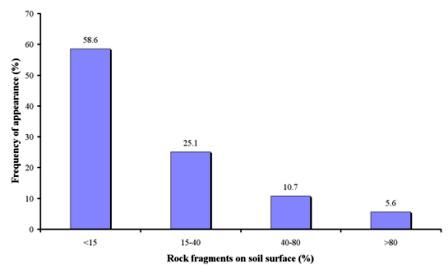Rock fragments
Pieces of rocks of 2 mm diameter or larger that are strongly cemented or more resistant to rupture are called rock fragments. They are present on the soil surface or distributed in various quantities into the soil body. Rock fragments, especially on the soil surface can have a great but variable effect on soil water conservation and soil erosion. Cobbles generally restrict evaporative water loss during periods of no- to moderate drought (e.g. from late fall to early summer) but they increase evaporation during the dry and hot summer. The higher amounts of soil moisture in stony soils, especially in late spring to early summer, positively affect plant growth and productivity of rainfed crops supporting a considerable biomass production, and protecting large areas from desertification. Pebbles on the soil surface can reduce surface water runoff and soil loss playing an important role on land protection from desertification. Soils containing considerable amount of rock fragments become warmer earlier in spring than the same soils free of rock fragments. This favors early plant growth and better use of available water.
Rock fragments are classified according to their diameter to the following categories: pebbles (diameter 2-75 mm), cobbles (diameter 75-250 mm), stones (diameter 250-600 mm), and boulders (diameter >600 mm). The percentage cover of the soil surface by rock fragments (RF) has been measured for the purpose of this project using the following four classes: (a) RF>80, (b) RF=40-80%, (c) RF=15-40%, and (d) RF<15%.
Rock fragments data have been collected from 1239 field sites, corresponding to 14 study sites (Table 3). The obtained data have shown that the majority (58.6%) of the field sites were free or with small amount of rock fragments (<15%) on the soil surface (Fig 19). All field sites described in Plateau-China and in Djanybek-Russia were free of rock fragments while in some cases have been measured in the rest of the study field sites. The next important class of rock fragment content was 15-40% found in 25.1% of the study field sites. Such field sites were found in all the rest study sites except for Plateau-China, Cointzio catchment-Mexico, and Djanybek-Russia. This class of rock fragment content on the soil surface is considered as the optimal for soil erosion protection. High amounts (40-80%) and very high amounts (>80%) have been measured in few field sites 10.7% and 5.6%, respectively. Such soils are characterized as very gravelly or skeletal resulting mainly from high erosion rates. They were found mainly in all study sites except for Plateau-China, Konya Karapinar plain-Turkey and Djanybek-Russia.

Fig. 19 Rock fragment content on the soil surface prevailing in the study field sites